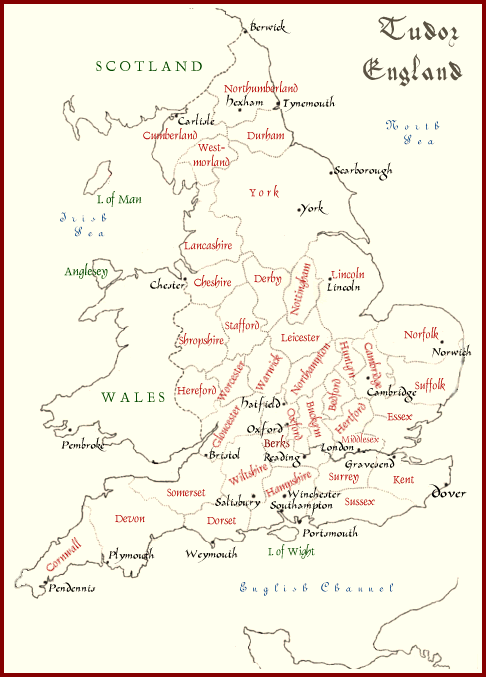
The Language of Sir Gawain and the Green Knight
The language of the Gawain-poet can be initially difficult for the modern reader, even if he is used to reading other Middle English poetry. There are good reasons for this, and they are important for how we interpret Sir Gawain and the Green Knight. The poem has survived in only one manuscript, which was written down in the opening years of the fifteenth century. However, we know that this manuscript contains a copy of the poem, and Sir Gawain and the Green Knight was probably first composed sometime between the years 1375-1399 (scholars differ on the dating). This makes the language contemporary with other famous fourteenth-century writers such as Geoffrey Chaucer, John Gower, and William Langland. The language of Chaucer makes for an interesting comparison, since, Chaucer's language is much easier for us to read. Why is this? The reason is that Chaucer wrote in the English of London, whereas the Gawain-poet wrote in the dialect of Cheshire a county in the Northwest Midlands of England on the border with Wales--some 190 miles from London. The following map (taken from Life in Elizabethan England) is for Tudor England (15th-16th centuries), but is approximately the same as for the later fourteenth century. Locate London on the southeastern corner of the map. Cheshire is the northwestern region just south of Lancashire and north of Shropshire.

The standard form of written English we use today developed from the dialect of London during the early fifteenth century, so it's no wonder that Chaucer's late fourteenth-century London English is so much easier for us to read. For a guide to the features of Chaucer's English, see the information on the Harvard Chaucer Web Site.
It's important to realise that the Gawain-poet's use Cheshire dialect would not have seemed odd at the time, since London English had not yet taken on the role of a national (and later international) standard for the written language. However, some scholars have argued that the very process whereby this took place meant that the regional poetic style (alliterative verse) and regional interests of the Gawain-poet and his peers were doomed to be relegated to footnotes of literary history. Hence, from the fifteenth century on, few copies of their poems were made, which is why we only have one copy of Sir Gawain and the Green Knight. Was this process already taking place in the Gawain-poet's time? Much debate has focused on the character of the Parson in Chaucer's Canterbury Tales. The Parson appologises for not telling his tale in verse:
But trusteth wel, I am a southern man.
I kan nat geeste 'rum, ram, ruf,' by lettre... (X.42-43)
This has been taken to be a reference to his unfamiliarity with northern alliterative verse, but, as he continues, 'Ne, God woot, rym holde I but litel bettre' (Nor, God knows, do I hold rhyme but little better), the debate is inconclusive. Regardless of the merits of these arguments, it is clear that, amongst writers in the Northwest Midlands, a literary dialect had developed which was governed by learned conventions of spelling, grammar, and vocabulary. In other words, just as today, the written language differed in systematic ways from the language as it was actually spoken aloud. Of course, just as today, writers did not always prevent the pronunciations and grammatical forms they used in speech from influencing their writing. Sometimes this even worked to their advantage in poetry, since they could choose either conventional or spoken forms to achieve desired rhythmic effects or rhymes.
The result of all this for the modern reader is that we should not expect absolute consistency in the grammatical forms and spellings used in the poem. We must learn to be flexible in our reading. One example should suffice. We will see forms we recognise such as şay knowe 'they know', but we are just as likely to see the plural form of the verb with other endings like şay tellen 'they tell', şay dares 'they dare'. We are seeing two phenomena here. First, Cheshire is on the border between the Northern dialect region and the West Midland dialect region: hence it is referred to as a 'Northwest Midland dialect'. In practice, this means that it has forms characteristic of both the other two (şay tellen is a Midland form and şay dares is a Northern form). Second, the original plural ending -en was starting to disappear, even in the Midlands, which is why we say 'they know' today instead of 'they knowen'. The Gawain-poet still has both forms in his repertoire, and using the -en form sometimes has rhythmic advantages for him, even if it was archaic even in the poet's own time. To the fourteenth-century reader of the poem, these variations must have looked very much like the variations between 'They did not go' and 'They didn't go' look to us. We have to learn to recognise and understand all the variations.
There are a few more things to be said concerning the background to the language of Sir Gawain and the Green Knight, but they are better examined under the rubric of the topics below. Click on these topics to learn more about how to read the dialect of the Gawain-poet.